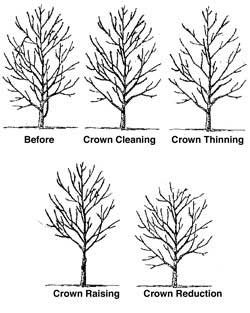
Pruning is a horticultural practice that alters the form and growth of a plant. Based on aesthetics and science, pruning can also be considered preventive maintenance. Many problems may be prevented by pruning correctly during formative years for a tree or shrub. It’s good to prune to promote plant health, remove dead branches or branches that are rubbing together. Pruning can also encourage flower and fruit development, and encourage hedge growth.
Timing is Everything!
The late dormant season is best for most pruning. Pruning in late winter, just before spring growth starts, leaves fresh wounds exposed for only a short length of time before new growth begins the wound sealing process. Another advantage of dormant pruning is that it’s easier to make pruning decisions without leaves obscuring plant branch structure. Pruning at the proper time can avoid certain disease and physiological problems:
Pruning at the proper time can avoid certain disease and physiological problems:
• To avoid oak wilt disease DO NOT prune oaks from April to October. If oaks are wounded or must be pruned during these months, apply wound dressing or latex paint to mask the odor of freshly cut wood so the beetles that spread oak wilt will not be attracted to the trees.
• To avoid increased likelihood of stem cankers, prune honey locusts when they are still dormant in late winter. If they must be pruned in summer, avoid rainy or humid weather conditions.
• Prune apple trees, including flowering crabapples, mountain ash, hawthorns and shrub cotoneasters in late winter (February-early April). Spring or summer pruning increases chances for infection and spread of the bacterial disease fireblight. Autumn or early winter pruning is more likely to result in drying and die-back at pruning sites.
• Some trees have free-flowing sap that “bleeds” after late winter or early spring pruning. Though this bleeding causes little harm, it may still be a source of concern. To prevent bleeding, you could prune the following trees after their leaves are fully expanded in late spring or early summer. Never remove more than 1/4 of the live foliage. Examples include:
— All maples, including box elder
— Butternut and walnut
— Birch and its relatives, ironwood and blue beech
 Prune before or after blooming?
Prune before or after blooming?
Trees and shrubs that bloom early in the growing season on last year’s growth should be pruned immediately after they finish blooming:
• apricot
• azalea
• chokeberry
•
chokecherry
• clove currant
• flowering plum
or cherry
• forsythia
• Juneberry
• lilac
• magnolia
• early blooming spirea
Shrubs grown primarily for their foliage rather than showy flowers should be pruned in spring, before growth begins:
alpine currant
barberry
buffalo berry
burning bush
dogwood
honeysuckle
ninebark
pea shrub
purpleleaf
sandcherry
smokebush
sumac
Shrubs that bloom on new growth may be pruned in spring before growth begins. Plants with marginally hardy stems such as clematis and shrub roses should be pruned back to live wood. Hardier shrubs such as late blooming spireas and smooth (snowball) hydrangeas should be pruned to the first pair of buds above the ground. To learn more about the best time to prune shrubs download the Shrub Pruning Calendar (PDF)
(Courtesy of the Virginia Cooperative Extension).
At Dos Amigos Landscaping we have the expertise to prune your trees and shrubs properly for maximum health and beauty of your trees, shrubs and landscaping. Right now (January to March) is the best time to prune most deciduous trees in Virginia. Contact us today we’ll come to your property, make an assessment and give you an estimate for pruning. Call Daniel Martin at 434-465-0075 to schedule an appointment or send an email.


